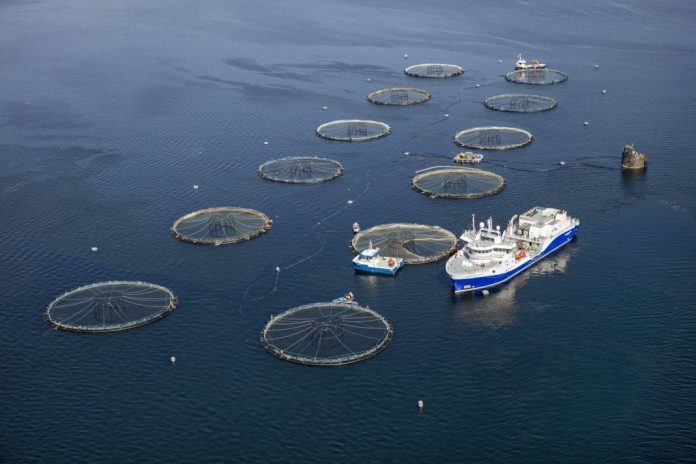The newly built well-boat ‘Inter Caledonia’ entered a five-year charter with Marine Harvest Scotland last April. During the construction phase, the company ordered a treatment system against lice and AGD [amoebic gill disease], developed by the Intership well boat company : a so-called RO plant with a capacity of 5,000 cubic meters of water per day.
“Reverse Osmosis (RO) removes the salt from seawater via membrane filtering, a well-known and proven technology from cruise ships. What’s exceptional here is the enormous capacity we have for a relatively small boat,” Internship’s owner Ole Peter Brandal told Salmon Business.
Water quality
The RO plant’s capacity is geared up to the need to maintain acceptable water quality during repeated treatments. Treatment efficiency increases dramatically by minimizing time loss involved in travelling to external freshwater sources, making it a cost-effective and chemical-free treatment. The system was installed in July 2016, and run-in during September that year. Since then, the boat has been almost exclusively used for freshwater salmon treatment.
“After inevitable teething problems, which are to be expected in a vessel as complex as this, the Inter Caledonia is now working very well,” Marine Harvest Scotland’s managing director, Ben Hadfield, told Salmon Business.
“Freshwater treatments are time-consuming, but once the vessel has established a rhythm and can work extended hours, entire farms can be treated, with very high mortality rates for sea lice and very low mortality rates for salmon. This helps our farming operations in Scotland continue to see much better biological results than in previous years.” 
“We are now working with the Intership Team to fine-tune and maximise freshwater production using the RO system,” Hadfield continued. “This has a cost and is not without challenges, but the control of lice and AGD is definitely improved as a result of using a vessel like this.”
Great value
The use of the RO plant is a pilot project with continuous adjustment and development after installation. The system, with all related systems, costs a total of approximately €4.1m.
“The effect of freshwater treatment has been visible from day one, but there has been a need for adjustments,” said Ole Peter Brandal. “AGD and lice have been a major challenge for Scotland, producing high mortality in 2014 and 2015, but now they have it under control. So the value of this project has been high.”
“It has been a boost for a new company, with a high risk,” said Brandal, clearly relieved that the venture has succeeded. “This surpasses all expectations and it can help Intership move on to new deals.” 
Loading and unloading of fish is done in a very gentle way, with over- and under-pressure and the use of 20 inch pipes. This is an essential part of the whole system and is an additional reason why there is no mortality associated with the treatment, explained Brandal.
“We do not use chemicals at all. Mortality is zero and the stress factor is very low. The fish feed directly after treatment. So there are gains from the point of view of economics, fish welfare and the environment, ” he continued.
“Marine Harvest had been operating a shuttle service with two large boats from an external source of water at a plant in Bessaker. ‘Inter Caledonia’ alone has higher capacity than those two. The effect of freshwater is no hocus pocus, the only bottleneck is the capacity. Wellboats must sail long distances to bring water of varying quality.”
 Intership Fleet Manager Kjetil Opshaug added: “We can maintain higher density and much higher quality. The water quality on land is very varied, and it takes up to 12 hours to fetch it. We are achieving the necessary quantity of sweet water with eight hours of teamwork and to better effect.”
Intership Fleet Manager Kjetil Opshaug added: “We can maintain higher density and much higher quality. The water quality on land is very varied, and it takes up to 12 hours to fetch it. We are achieving the necessary quantity of sweet water with eight hours of teamwork and to better effect.”
Countries around the North Sea
Opshaug explained that retrofitting such an RO facility to existing boats is impractical. It should be combined with building new ones, he believes.
Fresh water treatment against salmon lice and AGD is common in several salmon producing countries around the North Sea, but the production of freshwater on board is not common for wellboats. ‘Inter Caledonia’ is the only one that does this, according to the Intership duo.
They predict that more shipping companies will start using RO.
“We hear that more and more people are thinking about it. If that’s a general development, we do not know, but we expect this will be quite common on new builds. We are learning more about this every day and we hope to capitalize on it,” Brandal said, adding that the use of freshwater is a preferred solution.
the use of freshwater is a preferred solution.
“Marine Harvest wanted to use it for two to three months, during the period when they had the biggest problems with AGD. Now they want to use RO all year. They definitely see the benefits. Our advantage is that we have made freshwater treatment effective, solving the capacity limitation that comes from collecting water from external sources.”
Freshwater treatment
Hadfield also emphasized the environmental benefits of using freshwater.
“The use of freshwater reduces medicine use and residual discharges to the environment. But let’s be clear: no credible science is saying that medicine use in salmon farming was or is unsustainable. That said, we all recognise that the industry was over-dependant on medicine use, and so it’s encouraging to see how this innovative industry can introduce medicinal, mechanical, biological and now freshwater treatments to meet the health challenges.”

